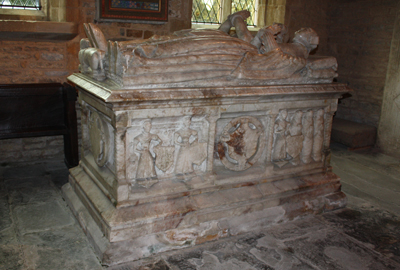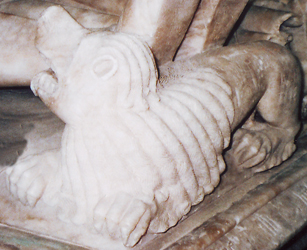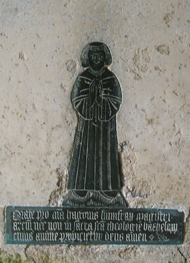The church, dedicated to St Martin, is the oldest building in the parish. Its building history is complex, suggesting that it was held in the affection and interest of parishioners at least until the early seventeenth century.
There may have been an earlier nave, but the earliest work to survive now in both nave and chancel dates to around 1190-1200.(1) A north aisle was added some thirty years later, about 1220. Its north wall was rebuilt, perhaps close to the date at which the tower was added in the fourteenth century; containing two chambers, it is entered from the aisle. An attempt was made in the next century to correct its tilt to the west by buttressing the southwest and northwest corners and rebuilding the upper stage; a further buttress was added between the earlier two in the sixteenth century, blocking the windows which light the chambers.
The fourteenth century font is the strongest reminder of the earlier beauty of the chancel and nave, where the arches of the north arcade sit on carved capitals. The south aisle was erected in the early sixteenth-century to accommodate the elaborate tomb of William Willington (d.1555) and his first wife, Anne Middlemore. Their arms adorn the shorter sides while their seven daughters decorate the longer. A blocked doorway in the west wall suggests that there may have been a plan to add an upper storey to the south porch, part of the earliest surviving church.
An inscription on the east pillar of the north arcade – THOMAS HORTON RECTOR HVIVS ECCLESIAE HOC PULPITUM PROPRIO SVMPTV EREXIT 1631 – reveals that he renewed the pulpit in addition to the repairs he carried out, noted in the Churchwardens’ Accounts already examined. There are monuments to four other rectors; all were originally buried in the chancel; the tomb stones of two are still there. A small brass to the priest Hugh Humfrey, now in the south aisle, was once also in the chancel as was a large incised stone slab now standing vertical in the south aisle. Both must have been moved during mid-nineteenth century restoration work.
Two drawings, said to be by John Buckler dated June 1823, show the east end and the font.(2) Twenty years later much of the seating was renewed in 1840 by ‘the late’ Mr Derrick of Oxford ‘under the superintendence of the late Mr Ellis of Shipston’ at the cost of £330.(3)
Major repairs and extensive restoration were carried out over twelve months 1869-70 when the church was closed for a year. According to the Leamington Spa Courier the work was supervised by Mr J Parker; but advertisements in that newspaper for 1 May 1869 (p.5) stated that ‘persons desirous of contracting for the restoration….can see plans and specification on and after 3 May….at the rectory. Tenders to be sent to the architect Ewen Christian, 8a Whitehall Place London before 29 May.(4) Elsewhere it was said that ‘as much of the old building as possible will be carefully preserved. New roofs to the chancel, nave and two aisles will be necessary; and new seats throughout in place of the present ones. The unsightly gallery will be removed.’(5)
The contract was awarded to Mr Alfred Groves of Milton, Chipping Norton who carried out the work at a cost of £1050. The church was re-opened on 1 March the following year by the Archdeacon of Worcester and 14 other clergymen. Attendance at the afternoon service was reported to have been small ‘in consequence of the unfavourable state of the weather’.(6)
One of the attractions for the congregation were the chained books, now deposited at the County Record Office, and the two chambers in the tower, described – incorrectly - as anchorites’ cells. Removal of the old plaster revealed the Norman doorway in the east wall of the north aisle. A seating plan of 1870 shows the reservations for the new pews, still in place.(7)
In 1905 the Willington tomb was restored. According to the Tamworth Herald, ‘the ancient alabaster tomb…had a coat of paint and the dirt of ages removed from it’ and it was rebuilt. The work was ‘done to the order of Mr John R Willington, a lineal descendant’.(8)

William Willington's tomb
Image © Hilary L Turner
The tower houses three bells, a tenor struck by Bartholomew Atton in 1596, another dated to 1720 by Richard Sanders and the third by Matthew Bagley of 1775. The communion plate includes an Elizabethan chalice dated to 1571; a transcript of an inventory of its possessions possibly around 1550 lists a chalice, three bells and a sanctus bell, five vestments one of which was velvet, three silk and one dornix and three copes, two of them of velvet and one of silk. (WaCRO DR 365/4, no source given).

The dog from Willington's tomb
Image © Hilary L Turner
The rectory was described in inventories of 1631 and 1639; it is not entirely clear whether the later seventeenth century rectors were resident but certainly towards the end of the next century some rectors lived elsewhere. Whether this was because they held livings in plurality or simply because the house at Barcheston was dilapidated is not known. A series of licences for non-residence were granted by the Diocesan from 17 December 1810 until 30 December 1830 ‘on account of the unfitness of the rectorial house’ and a later survey of Worcester parishes stated that the manor house and the parsonage were pulled down at the beginning of the nineteenth century.(9) That remark is true of at least part of the manor house.
The parish no longer has a resident rector or curate, but is part of the South Warwickshire Seven Group, united with Barton on the Heath, Burmington, Cherington with Stourton, Long Compton, Whichford and Wolford. Formerly in the deanery of Kington (Kineton) and once within the diocese of Worcester, the benefice is now in the diocese of Coventry, the Archdeaconry of Warwick and the deanery of Shipston. The living has never been very rich. It was valued at £13. 6s 8d in 1535 and later received money from Queen Anne’s Bounty, a fund established in 1704 to augment the income of the poorer clergy.(10)
The Parish Registers
The registers begin in 1559: christenings: 1559-1979, marriages: 1559-1979, burials: 1559-1979 with Banns 1756-1935. The originals are in Warwickshire County Record Office - DR 5/1-6 – and are now on Ancestry, with frequent omissions and many mistakes in transcription.
Church Wardens’ Accounts 1626-1725, also in the Record Office - DR 5/6 – were edited by E A Barnard, Old Barcheston 1626-1725, privately printed (200 copies) Journal Press, Evesham 1927.
Links to PDFs
References:
1. See http://www.british-history.ac.uk/report.aspx?compid=57027#s1 for the best account, Victoria County History Warwickshire, vol 5.
2. British Library, Add Ms 36390, f. 38, 39.
3. Leamington Spa Courier, 2 July 1892, p.3.
4. Leamington Spa Courier 1 May 1869, p.5.
5. Berrows Worcester Journal 17 July 1869, p.3.
6. Worcestershire Chronicle 9 March 1870, p.3; Jacksons Oxford Journal 19 March 1870, p.8.
7. WaCRO DR 354/10.
8. Tamworth Herald, 30 September 1905 p. 5.
9. E.A.B.Barnard, in ‘The Sheldon weavers and their work’, Archaeologia 78 (1928), p.271;. George Miller’s Parishes of the Diocese of Worcester (1889), vol i, p.40.
10. Valor Ecclesiasticus,ed,. John Caley, London, Record Commission 1810-33, vol III, p.96b





